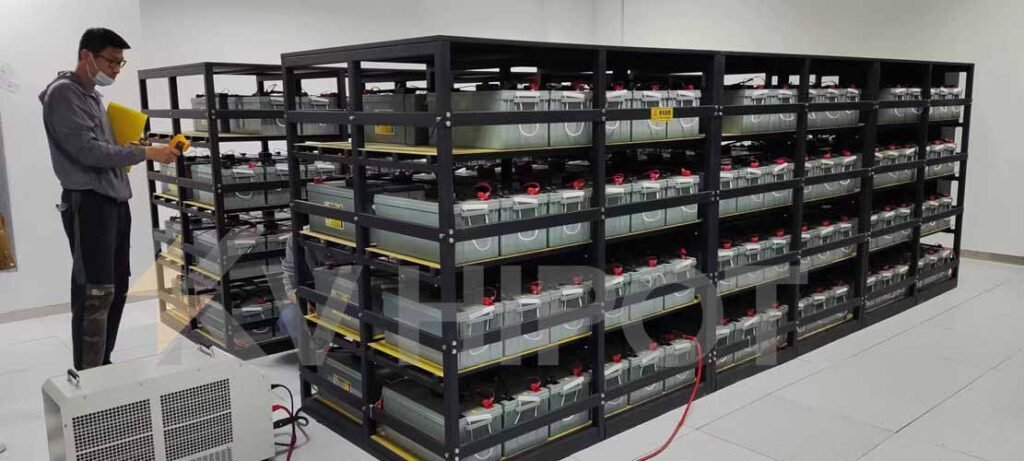Backup power systems are vital for preventing disruptions in critical operations caused by unexpected power outages. Whether due to natural disasters, equipment failures, or grid instability, power interruptions can have severe consequences, including financial losses, compromised safety, and system damage. Backup power systems provide a seamless transition to alternative energy sources, ensuring that essential services remain operational.
Industries such as telecommunications, healthcare, data centers, and utilities heavily rely on backup power systems to maintain uptime and protect critical assets. These systems bridge the gap between a power outage and the restoration of the primary power source, acting as a safety net for both large-scale infrastructure and smaller critical applications.
I. Importance of Batteries in Backup Power Systems
In critical power facilities such as DC power plants, substations, switchgear systems and power generation and transmission networks, uninterrupted DC power supply is essential for ensuring reliable operation. In the event of a power failure, backup battery groups act as the last line of defense, maintaining the supply of DC power to critical equipment like relays, communication systems, and control devices.
Batteries are the backbone of most backup power systems. They serve as an immediate power source when the primary electricity supply fails. Unlike generators, which may require startup time, batteries provide instant power, ensuring a seamless operation of connected systems.
II. What Are Backup Power Systems?
Backup power systems are designed to ensure the continuous operation of critical infrastructure during power outages. These systems serve as a safeguard against interruptions caused by grid failures, natural disasters, or equipment malfunctions, which can disrupt essential services and operations.
By automatically or manually activating during a power outage, backup power systems help maintain safety, prevent data loss, and avoid costly downtime in sensitive environments. They are indispensable in critical industries, where even a brief power failure can lead to significant consequences.
Examples of systems relying on backup power include:
- Telecommunications:Ensuring uninterrupted network connectivity and communication.
- Hospitals:Powering life-saving equipment and critical healthcare systems.
- Utilities:Maintaining the stability of substations and grid operations.
- Data Centers:Preventing server shutdowns and protecting data integrity.
- Industrial Plants:Supporting emergency shutdown systems and key processes.
Backup power systems typically include batteries, generators, and control mechanisms that work together to provide a reliable and immediate response to power loss.
The Role of Batteries in Backup Systems
Batteries are the most critical component of many backup power systems due to their ability to deliver instantaneous power without any startup delay. Unlike generators, which may require several seconds to activate, batteries provide seamless support, ensuring continuous operation during the initial moments of an outage.
Types of Batteries Used in Backup Power Systems:
- Lead-Acid Batteries:
- Widely used in uninterruptible power supply (UPS) systems.
- Affordable and reliable but require regular maintenance and have a shorter lifespan.
2. Lithium-Ion Batteries:
- Lightweight and energy-dense, suitable for modern systems like renewable energy storage.
- Longer lifespan and lower maintenance compared to lead-acid batteries.
3. Nickel-Cadmium (Ni-Cd) Batteries:
- Known for durability and ability to operate in extreme temperatures.
- Typically used in industrial and aerospace applications.
Challenges in Managing Battery Health:
- Aging:Over time, battery capacity diminishes due to chemical wear and tear.
- Temperature Effects:Extreme heat or cold can reduce battery efficiency and lifespan.
- Cycling:Repeated charging and discharging can degrade battery performance.
Effective management of battery health is essential to ensuring the reliability of backup power systems. Regular testing and maintenance using advanced battery test equipment are key to diagnosing issues early, optimizing battery performance, and preventing unexpected failures during critical moments.
III. The Role of Battery Test Equipment in Maintaining Reliability
The reliability of power utility system determines on the health of the backup batteries. A single weak or failing battery can compromise the entire backup system, potentially leading to costly downtimes or catastrophic failures. Therefore, it is crucial to assess the state of health (SOH) of batteries before they fail.
Key reasons for regular battery health assessment include:
- Ensuring Reliability: Early detection of aging or degraded batteries prevents unexpected power interruptions during critical moments.
- Proactive Maintenance: Identifying underperforming batteries allows for timely replacement or maintenance, reducing emergency repair needs.
- Cost Efficiency: Prolonging battery life and avoiding unnecessary replacements optimize maintenance budgets.
- System Protection: Healthy batteries ensure proper operation of essential systems like circuit breakers, relays, and alarms.
- Tools like impedance testers, discharge testers, and real-time monitoring systems play a pivotal role in identifying issues such as capacity degradation, internal resistance increase, and voltage irregularities. These assessments enable operators to maintain a reliable and robust backup power system, reinforcing the overall stability of power facilities.
Battery test equipment plays a pivotal role in ensuring the reliability and performance of backup power systems. Without regular testing, batteries can fail unexpectedly, compromising the entire backup system.
Key functions of battery test equipment include:
- Health Monitoring:Evaluating the battery’s state of health (SOH) to determine its remaining lifespan.
- Capacity Verification:Measuring the battery’s ability to deliver the required power during an outage.
- Fault Detection:Identifying issues such as sulfation, corrosion, or internal resistance before they lead to failure.
- Compliance and Reporting:Ensuring the system meets industry standards and providing detailed performance records for audits or predictive maintenance.
By using advanced battery test equipment, operators can proactively address potential failures, optimize maintenance schedules, and extend battery life, ultimately ensuring that backup power systems perform reliably during emergencies.
IV. Battery Test Equipment
Battery test equipment is essential for maintaining the reliability and performance of batteries in backup power systems. These tools play a crucial role in ensuring that batteries function as expected during critical moments and remain in optimal condition throughout their lifecycle.
Key purposes of battery test equipment include:
- Ensuring Reliable Performance:
- Verifies that batteries can deliver the required power during outages.
- Prevents operational disruptions by confirming battery readiness.
- Diagnosing Potential Failures:
- Identifies issues such as internal resistance, capacity loss, or aging before they lead to failure.
- Enables timely maintenance or replacement to avoid unexpected downtime.
By regularly testing batteries, operators can proactively manage battery health, optimize system reliability, and prevent costly or dangerous failures during emergencies.
V .Key Tests Performed by Battery Test Equipment
Battery Discharger
Battery Discharger is a device used to test and maintain the performance of a battery system by simulating a load on the battery by constinuously the discharge current . It can carry out the discharge test to verify the battery real capacity .

Battery Discharge Testing:
- Purpose:Measures the battery’s capacity to deliver power over a specified period.Determining the battery’s ability to deliver the required power by discharging it to a specified load.
- How It Works: Simulates real-world conditions by discharging the battery under controlled loads.
- Significance: Verifies the battery’s ability to supply power when needed, helping detect capacity degradation and ensuring backup systems function effectively during outages.
Battery Capacity Tester
Battery Capacity Tester (Battery internal resistance tester ) is designed using the advanced AC discharge measurement method for testing cell internal resistance and voltage to judge the battery capacity and technical state.

Battery Impedance Testing:
- Purpose:Evaluates the internal resistance of a battery to identify potential issues.
- How It Works:Sends a small AC signal through the battery and measures the response.
- Significance:Early detection of problems like sulfation or electrode damage, allowing for preventive maintenance before performance significantly declines.
Battery Charger Discharger
Battery Charger Discharger is a comprehensive all-in-one machine which can proceed the battery capacity test, battery charging and battery activating . It can set multiple cycles of charging and discharging to activate the lag batteries and restore battery performance.

- Key purposes include:
- Battery Conditioning:Ensuring batteries are properly charged and discharged to maintain their health and performance.
- Capacity Testing:Determining the battery’s ability to deliver the required power by discharging it to a specified load.
- Battery Health Monitoring:Assessing the battery’s performance over time to detect aging or degradation.
- Simulation of Real-World Conditions:Mimicking the battery’s operational environment by charging and discharging it in a controlled manner to assess its reliability.
2. How It Works
A battery charger-discharger typically has two main modes: charging and discharging.
Charging Mode:
- The device connects to the battery, supplying a constant current or voltage to replenish the battery’s charge.
- Modern chargers are equipped with charging algorithms to prevent overcharging and ensure the battery is charged within safe limits.
- Charging may include stages like bulk charge, absorption charge, and float charge, depending on the battery chemistry.
Discharging Mode:
- In discharging mode, the charger-discharger applies a constant load to the battery, gradually drawing power until it reaches a cutoff voltage or the battery is drained to a preset level.
- The discharge process allows for testing the battery’s capacity to deliver energy over a period, as well as assessing its voltage behavior under load.
Data Logging & Monitoring:
- Advanced models are equipped with real-time data logging, monitoring the battery’s voltage, current, and temperature during both charging and discharging cycles.
- This data is used to evaluate the battery’s efficiency, state of charge (SOC), and state of health (SOH), helping to predict the remaining lifespan or failure points.
Battery test equipment not only ensures that backup power systems perform during critical moments but also helps extend battery life, reduce maintenance costs, and enhance overall system safety. By leveraging these tools, operators can maintain confidence in their power systems’ ability to handle emergencies.
VI、Benefits of Using Battery Test Equipment for Backup Power Systems
1. Enhanced Reliability
Battery test equipment ensures the uninterrupted performance of backup power systems by proactively identifying issues before they escalate into critical failures.
- Early Fault Detection:Advanced testing can reveal signs of capacity loss, internal resistance increase, or other indicators of battery deterioration.
- Prevention of System Downtime:By replacing or repairing failing batteries before they fail, backup power systems remain reliable during emergencies.
This proactive approach minimizes the risk of operational disruptions, safeguarding critical applications such as data centers, substations, and hospitals.
2. Prolonged Battery Life
Accurate testing helps optimize battery maintenance strategies, extending the usable life of backup power batteries.
- Avoiding Premature Replacements:By assessing the actual condition of each battery, operators can avoid unnecessary replacements based on conservative time-based schedules.
- Balanced Usage:Identifying and addressing weak batteries ensures that all units in a string perform consistently, reducing stress on the system and prolonging overall battery life.
Regular testing ensures that maintenance efforts are efficient and cost-effective, maximizing the return on investment for backup power systems.
3. Cost Savings
Battery test equipment helps organizations save money by reducing unplanned expenses and optimizing resource use.
- Preventing Outages:Early detection of battery issues reduces the likelihood of expensive downtime or equipment damage caused by power failures.
- Lower Maintenance Costs:Scheduled testing minimizes the need for emergency repairs, while accurate data enables better inventory management for spare batteries.
- Optimized Asset Utilization:Extending battery life and reducing waste ensures cost-efficient system operation.
For businesses that rely heavily on uninterrupted power, these savings can be significant, enhancing overall operational efficiency.
4. Compliance with Standards
Backup power systems must meet rigorous industry standards to ensure reliability and safety, especially in critical sectors such as healthcare, utilities, and telecommunications.
- Regulatory Requirements:Battery testing helps demonstrate compliance with standards like IEEE 450 (for lead-acid batteries) and IEEE 1188 (for nickel-cadmium batteries).
- Detailed Reporting:Modern test equipment provides comprehensive records of battery performance, which can be used for audits, inspections, and predictive maintenance planning.
- Enhanced Safety:Ensuring that batteries operate within safe parameters reduces risks associated with overheating, overcharging, or unexpected failure.
Meeting these standards not only improves operational confidence but also protects organizations from potential





